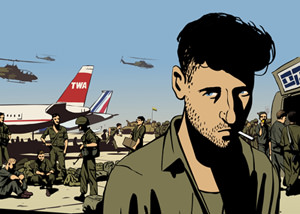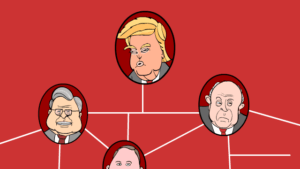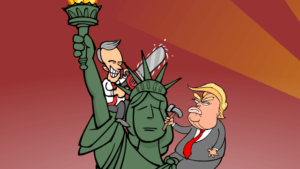Tragedy Repeats Itself
With Gaza exploding in violence and the eyes of the world fixed once again on the Middle East, "Waltz With Bashir" may be the most important movie of the season. As an "animated documentary," it's also in a genre all its own.
Several months ago, when Ari Folman was promoting his new animated documentary, “Waltz With Bashir,” the film screened for a Palestinian audience in Ramallah, less than 40 miles from his home in Tel Aviv.
The director was asked not to attend.
Folman had already traveled far and wide to promote the movie, which had received wildly enthusiastic accolades everywhere from Cannes to Auckland. But the French company presenting in Ramallah had asked the 45-year-old war veteran not to come to this screening so close to home, because it was not sure it could guarantee his safety. The company had a point: “Waltz With Bashir,” a graphic and violent series of recollections of the 1982 war in Lebanon, told almost entirely from the point of view of Israeli soldiers, culminates in bloody live footage of the aftermath of the infamous Sabra and Shatilla refugee camp massacres in which thousands of Palestinian men, women and children were murdered by Christian militia with Israeli troops stationed directly outside the camps.
As it turned out, the audience response in Ramallah, though passionate, was the kind every filmmaker dreams of: There was high demand for more screenings, because there wasn’t enough room in the theater for all the people who wanted to see the film.
This did not surprise Folman, whose intent for his documentary was always to tell a universal story, not a specifically political one: “I show how stupid wars are,” he said in a telephone interview. “I wanted to make a movie that no teenager could watch and think ‘Oh, sure, war sucks, but those soldiers are cool.’ There is nothing cool or glamorous about war.”
Folman should know. He was just 19 when he was flown over the Lebanese border for the Israeli offensive in 1982, and as we learn in the film, he passed the flight daydreaming about a romantic death in battle, hoping to inspire regret in the heart of the girlfriend who had just dumped him. What the boy found instead was fear, and absurdity, and enough trauma to blot out his memories.
It would be 20 years before Folman, now a successful screenwriter and director who barely even thought about his time as a soldier, would be forced to grapple with the meaning of his wartime experiences. He was 40 years old and tired of his time in the Israeli reserves, where he’d been put to work writing scenarios for military videos explaining, among other things, the proper care and feeding of gas masks. The army agreed to let him go — but only if he would agree to a series of exit interviews with a therapist.
Thought not a big believer in psychotherapy, he took the deal. Over the course of eight or nine sessions, he realized that he had no memory whatsoever of the massacres themselves, even though he had been stationed nearby. He then set out on a quest, both personal and professional, for answers to the questions that had come up in therapy: What had happened to him in Beirut? What had he seen? Why couldn’t he remember? What had the war done to him?
Folman sought out classmates, as well as men from his old unit and the first Israeli reporter on the scene of the massacres, and gathered their stories. He consulted an expert in post-traumatic stress disorder. He reached out to his best friend, Ori Sivan (listed in the credits as “filmmaker and shrink”), and he set out to make a film that would capture the surrealism of war and the fluidity of memory. He had already experimented successfully with animation for his popular Israeli TV show “The Material That Love Is Made Of,” and so he hired the artist Yoni Goodman, a gifted illustrator, and then set about trying to raise the money to get his movie made. Despite the modest $2 million budget of “Waltz With Bashir,” potential investors were reluctant to back the film — the first feature-length animated documentary ever made, and Folman ended up having to mortgage his house.
“I knew it had to be this way,” he explained. “If I couldn’t animate the film, I couldn’t do it at all.”
Folman and his animators filled the movie with dreams, memories and nightmares, all set to a soundtrack that alternates between rock music and Max Richter’s haunting score: A pack of dogs running rabid and wild though the streets, an exhilarating sequence of young soldiers boogie-boarding at the beach (Folman admits this was an intentional homage to “Apocalypse Now”), a teenage soldier dreaming that he’s being swum to safety by a giant naked woman, and, finally, Folman’s only clue to his blocked memory: a recurring dream about emerging naked from the sea.
The film owes much of its visual impact to the artistry of Goldman and his animation team, but its dramatic tension derives from Folman’s own Jason Bourne-style search for his missing memories. But when it comes time for the moment of revelation, the “Bourne moment” that might unlock his memory, Folman’s friend Ori hits him with an apparent anticlimax: the suggestion that his obsession stems from a much earlier moment in history — that his dreams are connected to an earlier massacre, an earlier nightmare.
“It’s all about those camps,” Ori suggests in the film. “Your parents were in Auschwitz. The massacre has been with you since you were 6 years old. … You felt guilty; you were cast for the role of the Nazi. It’s true you didn’t massacre. You just fired flares.”
As a child of survivors, said Folman, he had long been preoccupied by questions of circles of responsibility during the Holocaust. “How much did they know? Did they realize there was a mass murder happening? How many knew what was going on in the camps?”
The same questions plagued him as he searched for his own memories of the Palestinian massacre, and as he spoke with soldiers who had been nearby. “What I learned was that people had all the elements, but they found it too complicated to put it together in one frame, because mass murder is not in our system. … You don’t think that things like that are happening just around the corner, even if you are participating in a war.”
In part, this is a particularly Jewish/Israeli problem, one which Folman does not shy away from: Is a culture that has experienced genocide more likely to recognize it the next time it appears? Not necessarily, says Folman, speaking personally again. “For us who grew up in those kinds of families, are we more ready to listen to those kinds of stories? On the contrary, I think it is harder. The Holocaust was like a one-time experience in the history of humankind for us. We are not ready for anything else.”
But Folman is adamant in insisting that there are no easy comparisons to be made between the Nazi murder of the Jews and the massacre at Sabra and Shatilla. “There is no comparison, there can be no comparison. But mass murder is mass murder, and it is something that the imagination cannot believe or accept, even while it is happening.”
War is horror beyond human comprehension: This is the theme of “Waltz With Bashir. “This film,” insisted Folman, “could have been made by an ex-American soldier in Vietnam, a Russian in Afghanistan, an American today in Iraq. … It could have been made by anyone who wakes up one morning and finds himself hundreds of kilometers away from home, in a remote city that has nothing to do with him or his life, nothing whatsoever. He doesn’t know what he’s doing there, he is terrified, and he has no clue.”
Asked if working on the film had turned him into a pacifist, Folman answered: “For that I didn’t need to make a movie. I became a pacifist by my second day in Lebanon.”
Click here to see clips from “Waltz With Bashir.”
Your support matters…Independent journalism is under threat and overshadowed by heavily funded mainstream media.
You can help level the playing field. Become a member.
Your tax-deductible contribution keeps us digging beneath the headlines to give you thought-provoking, investigative reporting and analysis that unearths what's really happening- without compromise.
Give today to support our courageous, independent journalists.






You need to be a supporter to comment.
There are currently no responses to this article.
Be the first to respond.